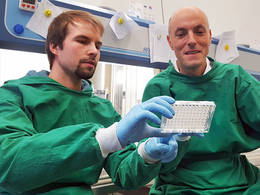Double strike against tuberculosis

Dr. Johannes Lehmann (left) and Prof. Stephan A. Sieber examine test results on the antibacterial effect of various substances. (Foto: Christian Fetzer / TUM)
Among the greatest challenges when treating life-threatening tuberculosis infections is the increasing resistance to antibiotics. But the pathogen itself also makes the life of doctors difficult: its dense mycomembrane hampers the effect of many medications.
A team of scientists headed by Stephan A. Sieber, Professor of Organic Chemistry at TU Munich, has discovered a substance that perturbs the formation of this membrane significantly.
The mycomembrane of the tuberculosis pathogen Mycobacterium tuberculosis consists of a lipid double layer that encapsulates the cell wall, forming an exterior barrier. Structural hallmarks are mycolic acids, branched beta-hydroxy fatty acids with two long hydrocarbon chains. The team hypothesizes that similarly structured beta lactones could “mask” themselves as mycolic acid to enter the mycolic acid metabolic pathways and then block the decisive enzymes.
Helpful disrupter
In the context of an extensive search, the interdisciplinary team of scientists hit the bullseye with the beta lactone EZ120. It does indeed inhibit the biosynthesis of the mycomembrane and kills mycobacteria effectively. Using enzyme assays and mass spectroscopy investigations, Dr. Johannes Lehmann, a researcher at the Chair of Organic Chemistry II at TU Munich, demonstrated during his doctoral work that the new inhibitor blocks especially the enzymes Pks13 and Ag85, which play a key role in the development of mycomembranes.
EZ120 is effective even in low doses, easily passes the mycomembrane and exhibits only low toxicity to human cells. The combined application of this substance with known antibiotics showed a synergistic effect leading to significantly increased effectiveness.”Vancomycin, a common antibiotic, and EZ120 work together very well,” says Prof. Sieber, who heads the Chair of Organic Chemistry II. “When used together, the dose can be reduced over 100-fold.
“The scientists suspect that disrupting the mycomembrane enables antibiotics to enter the bacteria more easily. This is a new mode of action and might be a starting point for novel tuberculosis therapies.
The research was funded by the German Research Foundation (SFB 749 and Cluster of Excellence “Center for Integrated Protein Science”), the National Institutes of Health (USA) and the German National Academic Foundation (Studienstiftung des Deutschen Volkes). Researchers from the Harvard T.H. Chan School of Public Health and Texas A & M University (College Station, USA) also participated in the research.
Publication:
An Antibacterial ß-Lactone Kills Mycobacterium tuberculosis by Disrupting Mycolic Acid BiosynthesisJohannes Lehmann, Tan-Yun Cheng, Anup Aggarwal, Annie S. Park, Evelyn Zeiler, Ravikiran M. Raju, Tatos Akopian, Olga Kandror, James C. Sacchettini, D. Branch Moody, Eric J. Rubin und Stephan A. SieberAngew Chem Int Ed Engl. 2017 Oct 24. doi: 10.1002/anie.201709365
Contact:
Prof. Dr. Stephan A. Sieber
Technical University of Munich
Chair of Organic Chemistry II
Phone: +49 89 289 13302
Mail: stephan.sieber@tum.de
https://www.tum.de/nc/en/about-tum/news/press-releases/detail/article/34383/
Media Contact
All latest news from the category: Life Sciences and Chemistry
Articles and reports from the Life Sciences and chemistry area deal with applied and basic research into modern biology, chemistry and human medicine.
Valuable information can be found on a range of life sciences fields including bacteriology, biochemistry, bionics, bioinformatics, biophysics, biotechnology, genetics, geobotany, human biology, marine biology, microbiology, molecular biology, cellular biology, zoology, bioinorganic chemistry, microchemistry and environmental chemistry.
Newest articles

Combatting disruptive ‘noise’ in quantum communication
In a significant milestone for quantum communication technology, an experiment has demonstrated how networks can be leveraged to combat disruptive ‘noise’ in quantum communications. The international effort led by researchers…

Stretchable quantum dot display
Intrinsically stretchable quantum dot-based light-emitting diodes achieved record-breaking performance. A team of South Korean scientists led by Professor KIM Dae-Hyeong of the Center for Nanoparticle Research within the Institute for…

Internet can achieve quantum speed with light saved as sound
Researchers at the University of Copenhagen’s Niels Bohr Institute have developed a new way to create quantum memory: A small drum can store data sent with light in its sonic…





















